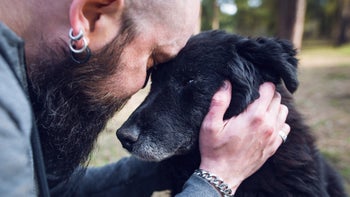
Understanding Dog Seizures: Learn the Signs and What to Do
Key takeaways:
Signs of a dog seizure include vomiting, circling, becoming clingy, and vocalizing. If your dog has a grand mal seizure, it can affect their full body, and they may lose consciousness.
Seizures in a dog look scary, but they are usually brief and don’t typically cause your pet any pain.
When you suspect a seizure, pay close attention to your dog, remove anything that can harm them during a seizure, and call your veterinarian.
Table of contents

As with cats and humans, dogs can also have seizures. These seizures happen when there’s unusual electrical activity in your dog’s brain.
It’s alarming for pet parents to witness their pup having a seizure. But it isn’t usually as traumatic for the animal. A dog seizure, which involves muscle spasms and involuntary movement, typically lasts from a few seconds to a few minutes. While it may seem like there’s nothing you can do, there are ways to keep your dog comfortable and help them recover safely.
Keep reading to learn the signs of a dog seizure, what causes seizures in dogs, and how to prevent and treat this condition.
Save on the top 10 pet medications
Save big on common pet medications like Fluoxetine and Levetiracetam at your local pharmacy.

GoodRx is NOT insurance. GoodRx Health information and resources are reviewed by our editorial staff with medical and healthcare policy and pricing experience. See our editorial policy for more detail. We also provide access to services offered by GoodRx and our partners when we think these services might be useful to our visitors. We may receive compensation when a user decides to leverage these services, but making them available does not influence the medical content our editorial staff provides.
What does a dog seizure look like?
Dog seizure symptoms can look a little different in every dog, especially if they have a localized seizure. Prior to a seizure, your dog may:
Stare into space
Become restless or clingy
Salivate
Snap their jaw
Produce loud vocalizations
Start circling
During a grand mal seizure, where the whole body is impacted, your dog may also show the following signs and symptoms:
Lose consciousness
Become unresponsive
Paddle their limbs
Pull their head backward
Salivate excessively
Urinate or defecate involuntarily
During a grand mal seizure, a dog’s entire body convulses. These seizures are easier to identify and can be quite dramatic. A localized or focal seizure, on the other hand, affects only one part of your dog’s body. You might notice a facial tremor or sudden rhythmic movement of a single limb or body part, for example.
Dog seizures can occur as a single event or as multiple seizures, called a cluster. Cluster seizures are defined as those that occur more than once in a 24-hour period.
What causes seizures in dogs?
According to Jennifer Frione, DVM, a veterinarian and owner of Lakeside Animal Hospital in Florida, a dog seizure can be a result of the following:
Structural issues within the brain, caused by brain tumors, trauma, or infection
Health issues outside the brain, such as hypoglycemia (low blood sugar), exposure to toxins, liver disease, or kidney disease
Idiopathic epilepsy, a condition that has no identifiable cause but leads to recurring seizures
Read more like this
Explore these related articles, suggested for readers like you.
What to do when your dog has a seizure
“When a dog has a seizure, to prevent suffering, remove surrounding objects that a pet may injure themselves on,” Frione recommended. It’s also important to remain calm, and don’t try to interrupt the seizure. You can’t stop a seizure in your dog immediately. But you can touch your dog to gently move them out of harm’s way, such as away from stairs or bodies of water.
Keep in mind that your dog is likely not in pain, even if they sound like it. Additionally, dogs don’t swallow their tongues during a seizure. Do not attempt to grab the animal’s tongue, as there’s a chance you may be bitten. Froth may appear at your dog’s mouth, but this does not mean they have rabies.
Seizures that last longer than 2 to 3 minutes can put dogs at risk of overheating. Pet parents can try cooling their dogs by wetting towels with cool — not freezing cold — water. If you can do so safely, place the towels around your dog’s neck, paws, or head.
Try to record your dog’s seizure on your phone. This way you can show it to your veterinarian. You may also want to log the event in a journal. Keep track of:
When the event took place
The length of the seizure
Exactly what happened
How often the seizures occur
Any recent trauma or injuries
If your dog was exposed to any toxins recently
This valuable information will help your veterinarian diagnose the cause of your dog’s seizure.
What should I do after my dog has a seizure?
If your dog had a first-time seizure or has multiple seizures within 24 hours, consider it an emergency. “Seek veterinary care immediately if your pet does not have a history of seizures and is having cluster seizures or prolonged grand mal seizures,” Frione said.
After a seizure, your dog may be disoriented or confused for a period of time. They may exhibit behaviors including:
Panting
Hyperactivity
Hunger
Fatigue
Thirst
A veterinary physical examination and routine lab tests can usually identify the cause of the seizure. In some cases, additional procedures such as MRIs, extra blood tests, and collection of spinal fluid may be required.
Your vet will let you know the best course of action following a seizure. If your dog is diagnosed with a condition that causes regular seizures, your vet will also let you know what to do if they have additional seizures.
How do you treat a dog seizure?
Treatment of dog seizures depends on any underlying conditions. If the seizure is a single event, a veterinary visit is recommended, but medication or other treatment may not be necessary.
In the event of a seizure that lasts more than 2 minutes or occurs multiple times over a short time frame, your dog may need to take anticonvulsant medications. These medications can help control the number and severity of seizure episodes, Frione said.
Common anticonvulsants include phenobarbital and levetiracetam (Keppra). Phenobarbital can take up to 2 weeks to take effect. Your vet may prescribe higher doses in the first 24 hours so that your dog benefits from the medication faster. How long your dog needs to take medication will depend on your dog and the medication.
“The length of treatment will be based on what medications are prescribed. However, once a pet is put on anticonvulsants, they are usually required for life,” Frione said. In these cases, it is possible for dogs to have a seizure if even a single dose of the medication is missed.
If your dog’s seizures are a result of brain tumors, surgical removal may reduce the seizures. In the event the seizure is caused by low blood sugar or liver or kidney diseases, treating the underlying condition may reduce the seizures.
If toxins are determined to be the cause of the seizure, your vet will recommend an appropriate treatment. And be sure to remove the toxin or poison from your dog’s environment.
The bottom line
Seizures in dogs can be treated and managed with prompt medical attention and careful observation of your pet during and after the seizure. During a seizure, stay calm and focused. Letting your pet handle the event on their own is usually recommended. There is no way to prevent your dog from having a seizure. But regular veterinary checkups — including vaccinations and blood work — can help identify any underlying conditions that can cause seizures.
Why trust our experts?



References
Brooks, W. (2021). Seizure disorders in dogs. Veterinary Partner.
Burke, A. (2021). If your dog’s having a seizure, here’s what you should do. American Kennel Club.
Cornell Richard P. Riney Canine Health Center. (n.d.). Managing seizures.




























